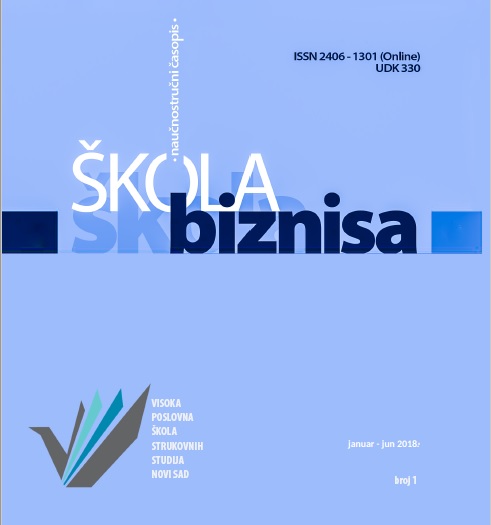„NOVI PUT SVILE“: EVROPSKA UNIJA, KINA I BUDUĆNOST TRGOVINE
Sažetak
Troškovi transporta su jedan od ključnih faktora koji oblikuju svetske trgovinske tokove. U cilju promovisanja olakšavanja saobraćaja i stvaranja povoljnog okruženja za efikasniji protok robe, kineska vlada je pokrenula inicijativu „Novi put svile“ 2013. godine. Jedno od glavnih pitanja koje ima uticaj na transport i, posledično, na budući razvoj ove inicijative su rastući trgovinski tokovi između Kine i Evropske unije. Interesantna činjenica u vezi sa Kinom, jasno naznačena, jeste da će nacija postati najveće svetsko tržište srednje klase u narednim decenijama. Očekuje se da će nedavna demografska transformacija u Kini - porast potrošača srednje klase - biti presudna za odnose između Kine i Evropske unije. Uz rastuću kupovnu moć i veću sklonost ka evropskim brendovima, potrošači sa srednjim prihodima u Kini su očigledno buduće ciljno tržište za brendove Evropske unije.
Reference
Amighini, A. (2017). Towards a New Geography of Trade? In A. Amighini (Eds.) China’s Belt and Road: a Game Changer?, Milan: The Italian Institute for International Political Studies (ISPI).
Behar, A. & Venables, A. J. (2010). Transport Costs and International Trade. Economics Series Working Papers 488, University of Oxford, Department of Economics.
Barton, D. (2013). The Rise of the Middle Class in China and Its Impact on the Chinese and World Economies. In China-United States Exchange Foundation (Eds.), US-China Economic Relations in the Next 10 Years: Towards Deeper Engagement and Mutual Benefit. Chapter 7, 138-148.
Barton, D., Chen, Y. & Jin, A. (2013). Mapping China’s Middle Class, McKinsey Quarterly, June.
Bernstein, W. J. (2008). A Splendid Exchange: How Trade Shaped the World. New York: Atlantic Monthly Press.
Bolle, M. & Kortsari, A. (2014). Europe-Asia Railway Transport: Issues and Prospects, Project NEAR², 7th Framework Programme, Grant Agreement No: 314254.
Chunrong, L. (2016). The Rise of a Middle-Class Society and its Implication for China-EU Relations. In S. Islam (Eds.), EU-CHINA Relations Discussion Paper New Directions, New Priorities, Discussion Paper, Friends of Europe.
Deepak, B. R. (2018). China's Global Rebalancing and the New Silk Road. Singapore: Springer.
Derudder, B., Liu, X. & Kunaka, C. (2018). Connectivity along Overland Corridors of the Belt and Road Initiative. MTI Global Practice Discussion Paper, No. 6. Washington, DC: World Bank.
European Commission (2018) European Union, Trade in Goods with China, Directorate-General for Trade.
Eurostat (2018) International Trade in Goods – A Statistical Picture, International Trade - Statistical Publications, October 30.
Eurostat Statistics, Extra-EU Trade by Partner, Available at https://ec.europa.eu/eurostat
Eurostat Statistics, Extra-EU Trade by Mode of Transport, Available at https://ec.europa.eu/eurostat
Guluzian, C.R. (2017). Making Inroads: China’s New Silk Road Initiative, Cato Journal, Vol. 37, No. 1, Winter.
Hansen, V. (2012). The Silk Road: A New History. London: Oxford University Press.
Herrero, A. G. & Xu, J. (2016). China’s Belt and Road Initiative: Can Europe Expect Trade Gains?, Bruegel Working Paper, Issue 5.
Herrero, A. G., Kwok, K. C., Xiangdong, L., Summers, T. & Yansheng, Z. (2017). EU–China economic relations to 2025: Building a Common Future. Joint Report by Bruegel, Chatham House, China Center for International Economic Exchanges and The Chinese University of Hong Kong. London: The Royal Institute of International Affairs.
Holslag, J. (2017). How China’s New Silk Road Threatens European Trade. The International Spectator: Italian Journal of International Affairs, 52(1), 46-60.
Islam, M. & Subran, L. (2017). Will the Chinese Consumer Save the World?, Allianz Euler Hermes Economic Insight, July 31.
Jovanovic, M.N., Damnjanovic, J. & Njegic, J. (2018). Euro-Asian Overland Transport Links: Prospects and Challenges, Handbook of International Trade and Transportation (eds. B. Blonigen and W. Wilson) Cheltenham: Edward Elgar, 602-627.
Kharas, H. (2017). “The Unprecedented Expansion of the Global Middle Class: An Update” Global Economy and Development, Working Paper 100. Washington, DC: Brookings Institution.
Konings, J. (2018). Trade Implications of the Belt and Road Initiative, ING Think Economics and Financial Analysis, 6 June, Amsterdam.
Leer, Y. & Yau, J. (2016). China’s New Silk Route the Long and Winding Road. 1st edition, PwC's Growth Markets Centre, February.
Li, Y., Bolton, K. & Westphal, T. (2016). “The Effect of the New Silk Road Railways on Aggregate Trade Volumes between China and Europe”, Institute of East Asia Studies Working Paper, No.109, Universität Duisburg Essen.
Office of the Leading Group for the Belt and Road
Silk Road Finance Cooperation, Belt and Road, Available at www.silkroad-finance.com/en/belt-road/
Starr, S.F, Cornell, S.E., & Norling, N. (2015). The EU, Central Asia, and the Development of Continental Transport and Trade, Silk Road Paper, Singapore: Central Asia-Caucasus Institute & Silk Road Studies Program.
The Economist (2014). China's Addiction to Luxury Goods, April 30th.
The Economist (2017). New Rail Routes between China and Europe will Change Trade Patterns, September 16th.
Wood, F. (2002). The Silk Road: Two Thousand Years in the Heart of Asia, Berkley: University of California Press.
World Bank, World Development Indicators: Structure of Merchandise Exports.
Zimmerman, T. (2015). The New Silk Roads: China, the U.S., and the Future of Central Asia. New York: Center on International Cooperation, 1-26.
- Autori zadržavaju autorska prava i pružaju časopisu pravo prvog objavljivanja rada i licenciraju ga "Creative Commons Attribution licencom" koja omogućava drugima da dele rad, uz uslov navođenja autorstva i izvornog objavljivanja u ovom časopisu.
- Autori mogu izraditi zasebne, ugovorne aranžmane za neekskluzivnu distribuciju članka objavljenog u časopisu (npr. postavljanje u institucionalni repozitorijum ili objavljivanje u knjizi), uz navođenje da je članak izvorno objavljen u ovom časopisu.
- Autorima je dozvoljeno i podstiču se da postave objavljeni članak onlajn (npr. u institucionalni repozitorijum ili na svoju internet stranicu) pre ili tokom postupka prijave rukopisa, s obzirom da takav postupak može voditi produktivnoj razmeni ideja i ranijoj i većoj citiranosti objavljenog članka (Vidi Efekti otvorenog pristupa).

